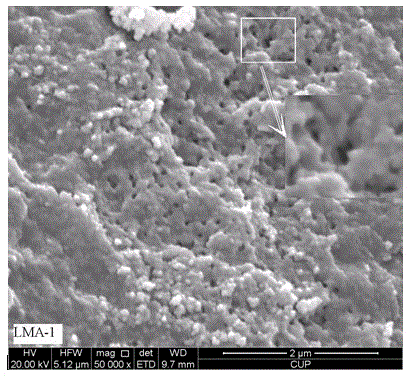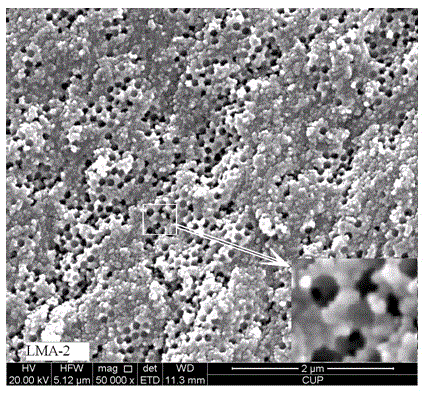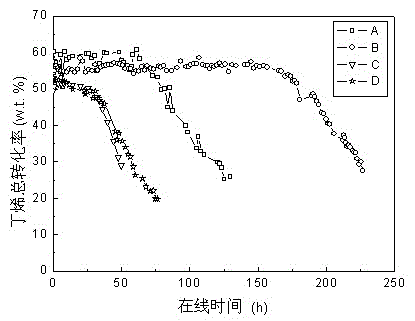Alumina carrier with composite pore structure and preparation method thereof
An alumina carrier and composite pore technology, applied in the field of materials, can solve the problems of uneven particle size of carbon black powder, difficult to control pore diameter, difficult to control the diameter of alumina carrier pores, etc. The effect of good penetration of large holes
- Summary
- Abstract
- Description
- Claims
- Application Information
AI Technical Summary
Problems solved by technology
Method used
Image
Examples
Embodiment 1
[0036] Synthesis of Polystyrene Microsphere Particle Template
[0037] Take 875ml of water, 0.884g of emulsifier sodium styrene sulfonate and 0.567g of stabilizer sodium bicarbonate into the reactor, stir and raise the temperature to 75°C, then add 125ml of styrene, continue stirring for 1h, add 0.567g of initiator over two Potassium sulfate, stirring at 75°C for 18 hours to obtain a monodisperse polystyrene emulsion. The particle size of the polystyrene microspheres measured by a Zetasizer Nano-ZS dynamic light scattering particle size analyzer of Malvern Instrument Co., Ltd. is 139 nm, and the relative standard deviation of the particle size is 3.2%. PS microspheres with other particle sizes can be obtained by adjusting the material ratio or reaction conditions.
Embodiment 2
[0039] One of preparation of mesoporous / macroporous alumina support
[0040] Disperse 40.8 g of SB powder in 1L of deionized water, stir and drop 1 mol / L nitric acid solution (until the pH of the suspension = 3.0-4.0) at 80°C for degumming, and obtain about 1 mol / L alumina Sol. Dissolve 34.8g of P123 in alumina sol, continue stirring for 1 hour, add PS microsphere suspension (the mass ratio of PS microspheres to alumina is 10%), mix well, and age the obtained material solution at room temperature , washed, filtered, dried, and then raised to 300°C at a rate of 1°C / min in a muffle furnace, then roasted at a constant temperature for 3 h, and then raised to 550°C at a rate of 1°C / min, and roasted at a constant temperature for 5 h , to obtain mesoporous / macroporous alumina support LMA-1. The BET specific surface area measured by nitrogen adsorption method is 230m 2 / g, the mesopore diameter is 13.4nm, and the mesopore volume is 0.89 cm 3 / g, the total pore volume measured by...
Embodiment 3
[0042] Preparation of Mesoporous / Macroporous Alumina Support Part 2
[0043] Disperse 40.8 g of SB powder in 1L of deionized water, stir and drop 1 mol / L nitric acid solution (until the pH of the suspension = 3.0-4.0) at 80°C for degumming, and obtain about 1 mol / L alumina Sol. Dissolve 34.8g of P123 in alumina sol, continue stirring for 1 hour, add PS microsphere suspension (the mass ratio of PS microspheres to alumina is 20%), mix well, and age the obtained material solution at room temperature , dried, and then raised to 300°C at a rate of 1°C / min in a muffle furnace, then calcined at a constant temperature for 3 h, and then raised to 550°C at a rate of 1°C / min, and calcined at a constant temperature for 5 h to obtain mesoporous / Macroporous alumina support LMA-2. The BET specific surface area measured by nitrogen adsorption method is 259m 2 / g, the mesopore diameter is 11.7nm, and the mesopore volume is 0.90 cm 3 / g, the pore volume measured by water titration is 1.6...
PUM
| Property | Measurement | Unit |
|---|---|---|
| Particle size | aaaaa | aaaaa |
| Specific surface area | aaaaa | aaaaa |
| Mesopore diameter | aaaaa | aaaaa |
Abstract
Description
Claims
Application Information
 Login to View More
Login to View More - R&D
- Intellectual Property
- Life Sciences
- Materials
- Tech Scout
- Unparalleled Data Quality
- Higher Quality Content
- 60% Fewer Hallucinations
Browse by: Latest US Patents, China's latest patents, Technical Efficacy Thesaurus, Application Domain, Technology Topic, Popular Technical Reports.
© 2025 PatSnap. All rights reserved.Legal|Privacy policy|Modern Slavery Act Transparency Statement|Sitemap|About US| Contact US: help@patsnap.com



